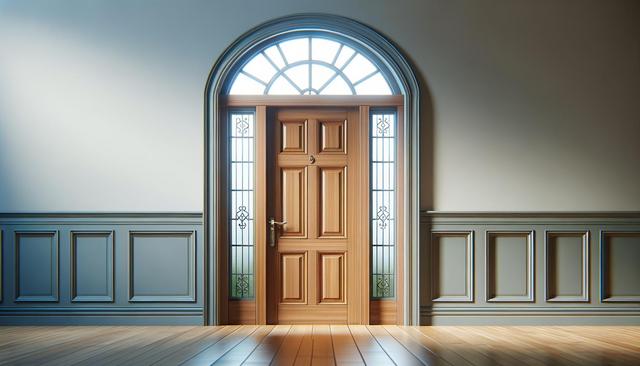Choosing the Right Entry Door Material
The material of your entry door plays a significant role in its durability, appearance, and energy efficiency. Homeowners today have a variety of materials to choose from, each offering distinct advantages. Common materials include steel, fiberglass, and wood, and each can be paired with various finishes and treatments to match your home’s aesthetic and functional needs. For example, steel doors are known for their strength and resistance to warping, while fiberglass doors can mimic the look of wood and offer excellent insulation. Wood doors, although requiring more maintenance, provide a classic look and natural warmth that appeals to many homeowners.
When selecting a door, consider factors such as climate, the level of maintenance you’re willing to perform, and your budget. Each material responds differently to weather conditions, so choosing one that suits your environment is crucial. For instance:
- Steel doors are ideal for high-security needs and harsh weather.
- Fiberglass doors resist dents and scratches, making them suitable for households with pets or children.
- Wood doors offer timeless charm but may need periodic refinishing.
By understanding the strengths of each material, you can select an entry door that complements your home while meeting long-term performance expectations.
Designs That Complement Your Home
The design of your front door can have a major impact on curb appeal and how your home is perceived from the street. Whether you’re looking for something modern, traditional, or transitional, there are countless design choices available. Decorative glass inserts, sidelights, and transoms can enhance the overall look and allow natural light to brighten your foyer without sacrificing privacy. Paneling, textures, and hardware options also contribute to the door’s aesthetic.
Many manufacturers offer customizable designs, allowing homeowners to choose colors, finishes, and accents that reflect their personal style. If you’re aiming for a sleek, contemporary look, consider a minimalist design with clean lines and metallic finishes. For a more classic appearance, raised panels and carved woodgrain textures might be more suitable.
Some design options to explore include:
- Full or half-glass panels for a light-filled entryway
- Frosted or stained glass for privacy with style
- Bold colors to make a visual statement
- Rustic finishes for a farmhouse or country home look
Matching your door design to the architecture of your home ensures harmony and visual appeal, helping to create a welcoming and polished entrance.
Security Features That Matter
Security is a top priority for any entry point to your home, and modern entry doors come with enhanced features to help keep you and your family safe. Reinforced cores, multi-point locking systems, and impact-resistant glass are just a few features that can significantly improve your front door’s security profile. The frame and installation are just as important as the door itself, as a weak frame can compromise even the strongest door.
Advanced hardware options now include smart locks, keyless entry systems, and video doorbells that integrate with home security systems. These not only add convenience but also provide real-time monitoring and alerts, offering peace of mind whether you’re home or away.
Key security features to consider include:
- Solid core construction for strength and durability
- Deadbolts with reinforced strike plates
- Smart lock compatibility for remote access
- Security-rated glass for break-in resistance
By investing in a secure entry door, you can deter potential intruders while also increasing the overall value and safety of your home.
Energy Efficiency and Insulation Benefits
An energy-efficient entry door helps maintain indoor temperatures, reduces energy bills, and contributes to a more comfortable living environment. Modern doors are typically insulated with polyurethane foam or other materials that provide excellent thermal performance. This insulation minimizes heat transfer, keeping your home warm in winter and cool in summer.
Weatherstripping, tight seals, and energy-efficient glass inserts also play a role in boosting your door’s performance. Doors with the proper energy ratings can contribute to a home’s overall energy efficiency, which is an attractive feature for eco-conscious homeowners and potential buyers alike.
Here are some energy-saving features to look for:
- High R-value insulation materials
- Low-E (low-emissivity) glass coatings
- Durable weatherstripping to prevent drafts
- Energy Star certification for verified performance
Choosing an energy-efficient entry door not only supports sustainability efforts but also leads to long-term cost savings. It’s a practical investment that benefits both your wallet and the environment.
Installation and Maintenance Considerations
Proper installation is essential to ensure your entry door performs well in terms of security, energy efficiency, and longevity. Even the highest-quality door can fall short if it’s not installed correctly. Professional installers ensure that the door fits properly within the frame, is level, and is sealed against drafts and water intrusion. They can also advise on any necessary structural adjustments or reinforcements.
Maintenance requirements vary depending on the material and finishes used. While steel and fiberglass doors generally require minimal upkeep, wood doors may need periodic painting or staining to protect against moisture and sun damage. Regularly cleaning the door, inspecting the hardware, and checking for signs of wear will help extend its lifespan.
Maintenance tips include:
- Clean surfaces with mild soap and water
- Lubricate hinges and locks annually
- Inspect weatherstripping for damage or gaps
- Repaint or reseal wood doors every few years
By staying on top of maintenance and ensuring professional installation, homeowners can enjoy the full benefits of their entry door for years to come.
Conclusion
Exploring front door options is a practical step toward enhancing your home’s style, security, and efficiency. With so many materials, designs, and features available, there’s an entry door to suit every home and preference. By considering factors like durability, insulation, and aesthetic appeal, you can make an informed decision that adds lasting value. Whether you’re upgrading for security or curb appeal, the right entry door can make a meaningful difference in both form and function.




Leave a Reply